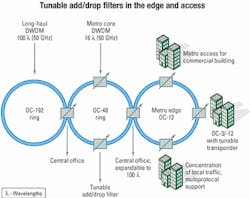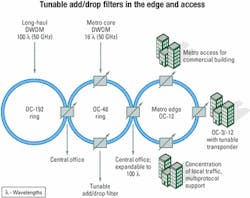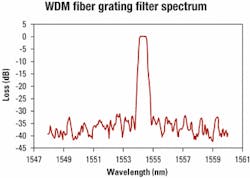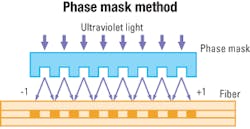Tunable grating filters are a disruptive technology
As a disruptive technology, tunable gratings can serve as the foundation for future metro-network equipment.
DR. PETER CHAN and DR. CHANGZUN ZHOU, Bragg Photonics Inc.
WDM technology has enabled the deployment of fat pipes linking continents via submarine networks and cities within continents using long-haul and ultra-long-haul systems. The question is, will a simple point-to-point network architecture solve the problem of the metro?
Indeed, it is a great challenge. Metropolitan systems need agility that supports rapid provisioning and scalability; they also must have the ability to expand incrementally so carriers pay only as they need to add capacity. Metro needs low cost as well-on a scale of a factor of 10. The metro core may require a factor of 100 cost reduction for metro access.
The need for bandwidth is still growing, but the current business model has failed to provide adequate return on investment. We must now focus on providing exit and on-ramps to our multilane freeways. Furthermore, we must start building an automobile industry. We are now riding bicycles with our 56k modems. This lack of access performance has prevented carriers from offering more profitable services.
The threshold we must cross is adequate speed and bandwidth at an affordable price. In the future, every business, as a network node, would like to talk to another business, maybe in the same city or in a city across the continent. The conventional WDM architecture would be too costly. Imagine: Each node will have to be equipped with 100 lasers. How can low costs realistically expect to be achieved?
Metro service providers will therefore need new network architecture: a dynamic or virtual WDM network. This network will support bandwidth-on-demand; simple and rapid provisioning, with various quality-of-service levels based on price; and automatic billing as customers select their choices of performance.This tunable WDM architecture (see Figure 1) will be enabled by several critical elements: switches, tunable lasers, tunable filters, and low-cost broadband optical amplifiers. We'll concentrate on tunable filters, particularly tunable grating filters (TGFs).
There are three emerging applications for tunable filters: network monitoring, bandwidth-on-demand, and complementary solutions to applications requiring tunable lasers. Each application will require a different mode of operation, which will determine the reliability of the module. TGFs offer full custom solutions for these applications, but they must meet the following important challenges:
- Reliability. The filter must meet the Telcordia guidance and support standards of at least 25 years of life. In the case of a TGF, we need to clearly understand its reliability performance under different stresses to predict its useful life.
- Resolution. Depending on the application, the tunable grating can be jumped from grid to grid (50 GHz or 100 GHz). In the case of network monitoring, it's preferable to scan the whole spectrum with sufficient resolution to observe in-channel power, channel activities, stability of the transmitting wavelengths, out-of-channel noise, and many other performance parameters.
- Repeatability. This capability is particularly important for tunable-laser applications. For example, a tunable laser used as a spare must be able to tune to the specified wavelength and hold accurately.
- Stability. Proper engineering of the filter is required so it is immune to environmental changes such as temperature and humidity.
- User-friendliness. Remote tunability allows carriers to monitor or provision the network from a central location. The tunable filter must incorporate intelligence for data collection, providing network statistics and performance information.
- Tuning range. For tunable gratings, there is a tradeoff between tuning range and reliability. A scanning mode, as used in network monitoring, is the most benign. Each cycle involves stretching and relaxation of the grating. Applications involving stretching and holding are more sensitive. With tunable lasers, for example, it might be wise to divide the useful spectrum into multiple bands. Under each sub-band, the stretching would be a small percentage of the elastic limit. That also coincides with most system implementations. Usually, a circuit pack will only contain four or eight transmitters. The logistics of carrying four spares, one of each circuit pack, is acceptable to most system builders.
- Footprint. In general, system builders prefer components with very small size and light weight. Being lightweight is particularly important for portable test equipment.
- Low power consumption. High power consumption also means heat. Excess heat requires air ventilation in the cabinet. Battery-operated portable equipment will also require low power demands.
- High-power handling. Metro networks are tributaries of the long-haul network, receiving data in the form of DWDM. In the future, it is conceivable to have more than 100 channels in fiber. Thus, the tunable filter must be future-ready, capable of handling up to 300 mW of total optical power.
- Availability. The technology behind the tunable filter must be manufacturable. A recent Communications Industry Researchers market research report projects that tunable filters will grow to $500 million by 2004, which represents a high-volume demand. High volume will drive down the price of the tunable filter.
- Flexibility. The technology must support various filter characteristics; each filter can be customized to suit a particular application. For example, a tunable filter can be inserted in front of a tunable laser as a tracking filter. In this case, the filter must have strong transmission loss and reasonable bandwidth.
A fiber Bragg grating is a wavelength-selective, reflective filter with a steep spectral profile (see Figure 2). It is formed by exposing ultraviolet light through a phase mask and recording the inference pattern as a periodic index change at the core of a germanium-doped silica strand (see Figure 3).
Grating technology was invented by the Communication Research Centre in Canada and United Technology of the United States. The two inventing organizations have teamed to offer licenses to companies interested in deploying grating technology. There are now up to 30 or more licensees, supporting a large variety of Telcordia-qualified products like pump lockers, WDM (100-GHz and 50-GHz) filters, and gain-flattening and dispersion compensation filters. Fiber Bragg gratings are considered a very mature technology and have already been deployed in high-reliability submarine networks and long-haul applications.The tunable grating filter is an extension of this mature technology. The optical fiber is a stretchable medium. As the fiber is stretched with the grating inside, the period size of the index perturbates and the effective refractive index will be changed, which would induce the shift of Bragg wavelength. That has the effect of changing the center wavelength of the filter. For example, before stretching:
λc = 2 neff νc,
where λc is the center wavelength of the grating filter, neff is the effective index of the fiber containing the gratings, and νc is the period size of the index perturbation.
By stretching the fiber grating with a strain of ε, we get a corresponding change in the center wavelength:where Pe is the effective photoelastic constant (approximately 0.22).
If the stretching is far below the elastic limit, this process is perfectly linear and recoverable. In fact, many grating manufacturers have used this effect to form the temperature compensation packaging for WDM, gain-flattening filters, and dispersion compensation.
Extending this concept provides the basis for tunable filters. The key to success is to achieve a high pull-strength grating process-the higher the pull-strength, the higher the elastic limit.
The design and manufacture of fiber gratings are well established and therefore meet the criteria of flexibility and user-friendliness. A custom grating can be developed as a special filter. Various filters can be adapted to common stretching mechanisms and can perform instantly. Filters can be made for C-, L-, S-band and even 1,310 nm in a matter of days. The next step is to select the appropriate tuning mechanisms.
There are several ways to stretch a fiber grating, including thermomechanical, piezoelectric, and actuator/stepper motor. For example, one patented thermal packaging technology has been extended to the thermomechanical method, but it is applied in reverse. In this case, the design uses a differential expansion element, which is susceptive to temperature change. A mechanical amplifier is designed into the mechanism so the expansion becomes magnified. A Peltier heating/cooling element is attached to the bi-metal structure. The resolution of such a filter is dependent on the ability to control the temperature of the Peltier.The benefit of this method is low cost. There are, however, several limitations: tuning speed is low, the heater needs time to stabilize the temperature of the bi-metal structure, and there is the influence of environmental temperature. The thermomechanical method also offers limited spectral range-up to 10 nm. This mechanism has been tested to 300,000 cycles with a center wavelength shift of <10 pm, which is within the measurement limit of the optical spectrum analyzer used in the reliability testing.
This method, once refined, will be suitable for low-cost tunable transponders for the metro. In particular, it should work well for customer premises equipment like the optical front end of an optical PBX type of application where speed is not as paramount.
Instead of using the bi-metal structure and the Peltier cooler, a piezoelectric stack can be substituted. This method has been deployed in conjunction with the mechanical amplifier structure. The controller for the piezo stack is more complex, since high voltages are required to drive the stack.
The piezoelectric effect provides fine resolution but limited range. A larger range can be obtained by adding several stacks on top of one another, but that adds to the size and cost. The piezoelectric effect has inherent hysteresis and necessitates the deployment of an external reference, which adds to the cost and complexity.
The only additional attribute of the piezoelectric method is speed enhancement. There is still the issue of influence from environmental conditions. Just like an arrayed-waveguide grating, which is very sensitive to temperature, the stretched grating must be maintained at an elevated temperature.
The stepper motor method provides middle-of-the-road performance and cost. Actuators have been deployed for large-capacity hard disks supporting hundreds of millions of movements. Access speed also can be optimized. It is capable of extended range. An actuator can be custom-designed based on the required stretching force and size. In this case, a load cell can be used to provide very accurate feedback on the amount of tension and can be correlated to physical displacement. It is therefore capable of providing the smallest-sized solution, a reasonable tuning speed, and optimized cost of ownership.
Since all the tuning mechanisms involve stretching of the fiber, tuning speed is always the issue. We do not see the current design ever achieving a subnanosecond tuning speed, whereby people might be interested in reading the optical headers. As far as rapid provisioning is concerned, the tunable-laser and tunable-filter applications mentioned here are quite sufficient.
Technology is in development that uses an electro-optic effect on polled Solgel material to achieve high-speed index modulation. Such integrated photonics technology will yield low-cost, multifunctional arrayed, fully integrated tunable devices. It is targeted at providing a factor of 100 cost reduction to optical access systems sitting in the customers' premises.
Mechanical failure will lead to complete loss of the optical performance of tunable fiber gratings. As a result, one important concern for a tunable filter will be its life endurance under certain tuning conditions. To improve the endurance, a high-strength grating is essential for building a reliable tunable filter. That will involve all of the procedures in production: fiber handling, stripping, grating printing, dust control in the production environment, and grating mounting. These precautions prevent seed defects from forming that could cause cracks and lead to failure.
When applied stress is not sufficiently high, mechanical failure occurs over time. This effect is referred to as fatigue, which can be characterized in two categories: static fatigue for constant applied stress and cyclic fatigue for variable applied stress.
For tunable filters, static fatigue might be related to long-term activity supervision on a predetermined channel and cyclic fatigue corresponds to frequent tuning among different channels. In a real application, tuning could be both static and cyclic. In that case, cumulative life consummation should be applied, which calculates residual life by integrating the consumed portion of fatigue life under different tuning conditions.
In addition to the tuning mode, the life endurance of a tunable filter can be affected by many other factors. The most important ones include tuning range, holding time at maximum, tuning speed, relaxation time, and environment.
Currently, there are not many publications available for cyclic fatigue of optical fiber. Fortunately, many different materials show similar cyclic fatigue; the life endurance will increase exponentially with decreasing load.For grating manufacturers, a preliminary objective will be to find experimentally the relationship between life endurance and tuning range (i.e., the fatigue curve) under different conditions. Based on the results obtained from experiments and crack propagation mechanisms, they would develop models to describe mechanical behavior of the tunable filter under complex conditions.
Effective deployment of tunable lasers, filters, and supporting subsystems will help network providers reduce their future cost of network systems (see Table). It will maximize and accelerate return on investment through their new ability to rapidly provision. Lower-cost tunable devices will eventually be affordable for fiber-to-the-business applications. Network control and management will gradually move from a centralized supplier-controlled structure to a user-friendly, custom-oriented, distributed control network architecture.
It may be sufficient to maintain a supervisory channel that contains the channel activities and is organized hierarchically to identify data targeted to stay within the metro core. Then each metro area can be identified similarly to our current area codes. Each metro will only be concerned with transfers within its domain. Of course, each metro core still has to allow pass-through traffic, linking together as a mesh in the intercity. It remains a mesh inside the metro, supporting virtual private networks for large volumes of data transfer on demand.
There are now a lot of forward-looking startup companies focused on building third-generation DWDM networks. There is also increasing interest from incumbent equipment builders. To ensure success, customers must select a highly responsive supplier with the best technology that fits the requirement.
Tunable filters are a disruptive technology capable of changing the landscape, reducing the cost of systems by a factor of 10, and allowing carriers to make more money and make it more quickly. If the carriers are successful, so will be the equipment builders. It is a partnership.
Dr. Peter Chan is the product manager for the tunable-filter product family and Dr. Changzun Zhou is the reliability engineering manager at Bragg Photonics (Montreal). They can be reached at [email protected] or [email protected].





